Did you watch the world-famous “Pixar films”? If your answer is yes, definitely you know about “Dory”. Because dory is the most popular cartoon fish character in Pixar films. If I said that you can do a miracle, would you believe it? Yes, you can bring this world-famous cartoon character, “Dory “into your home. This amazing fish, namely Blue Tang can be reared in your saltwater aquarium. Following guidelines help you to give love and care to your fish.
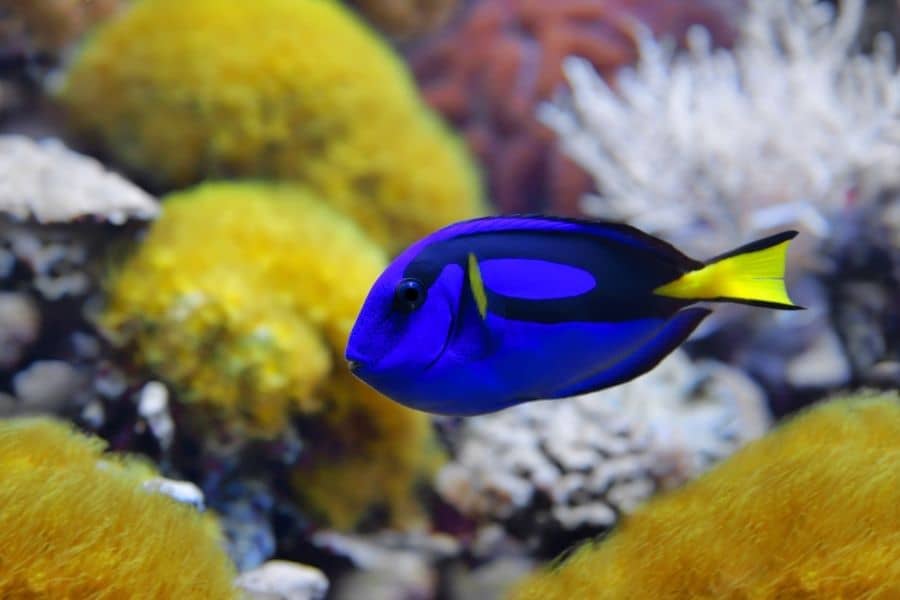
Blue Tang; who are they?
Jump To
- 1 Blue Tang; who are they?
- 2 What is blue tang and their Appearance?
- 3 What are the other names of blue tang?
- 4 How big does blue tang get?
- 5 Behavior
- 6 Blue tang lifespan
- 7 Blue tang care in Aquariums
- 8 Water quality conditions required
- 9 How does Blue tang breed in the wild?
- 10 How do identify female blue tang?
- 11 What are the benefits of farming Blue tangs?
- 12 What does blue tang eat in the wild?
- 13 What fish can live with blue tang in an aquarium?
- 14 Blue tang diseases
- 15 Related questions
The Pacific Blue Tang or Blue Hippo Tang is one of the most active swimmers among the Tangs. They are members of surgeon fishes. They are one of the best-looking Tangs that can be kept in your aquarium. The blue tang belongs to the genus Paracanthurus. The scientific name is Paracanthurus hepatus. They were found in tropical waters of India and the Pacific Ocean range. Generally, they are associated with coral reef areas.
What is blue tang and their Appearance?
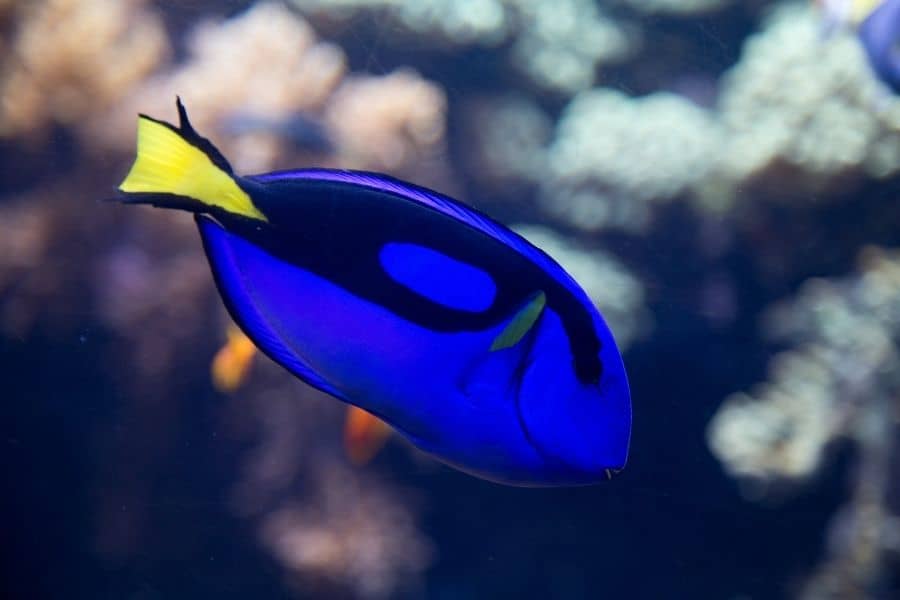
Blue tangs have a royal blue color body and a yellow color tail. The bold black “palette” design adds an amazing look to their appearance. These are black stripes with a unique pattern over the Blue Tang body. Their caudal fin is a bright yellow color. This fin also has black markings on the top and bottom sides. Their body shapes are relatively flat and have pointed mouths. This pointed mouth facilitates the nipping of algae from the rocks and corals.
It has small scales that give an illusion for the fish. Moreover, they have a sharp spine (caudal spine) on their caudal fin and it is used for self-defense against predators. The caudal spine contains a toxin that has the ability to give severe pain to predatory animals. But most aquarists and fish lovers rear them without any hurt. However, if you rear them with proper care, they will never hurt you.
What are the other names of blue tang?
These fish are also known as Blue Hippo, Hippo Tang, Regal Tang, Flagtail Surgeonfish, Royal blue Tang, Palette Surgeonfish, or Paracanthurus.
How big does blue tang get?
In their native environment, they can grow up to around 12 inches in size. But in captivity, this size will vary due to some factors. Those factors are tank space, feed quality, feed availability, water quality parameters, and tank mates.
Behavior
The behavior of blue tang
Blue tang or Blue hippo is a fast-swimming schooling fish. That means, they like to swim as a group. They create large schools in the wild and swim together through coral reefs. Because of their vibrant colors and unique body shape, their swimming behaviors add extra beauty to the coral reef environment. Since they are grazers, they pick algae from the coral reefs and associated stones. They are also considered a reef-safe variety. Moreover, they are hiding in reef caves and cavities to protect themselves from predators.
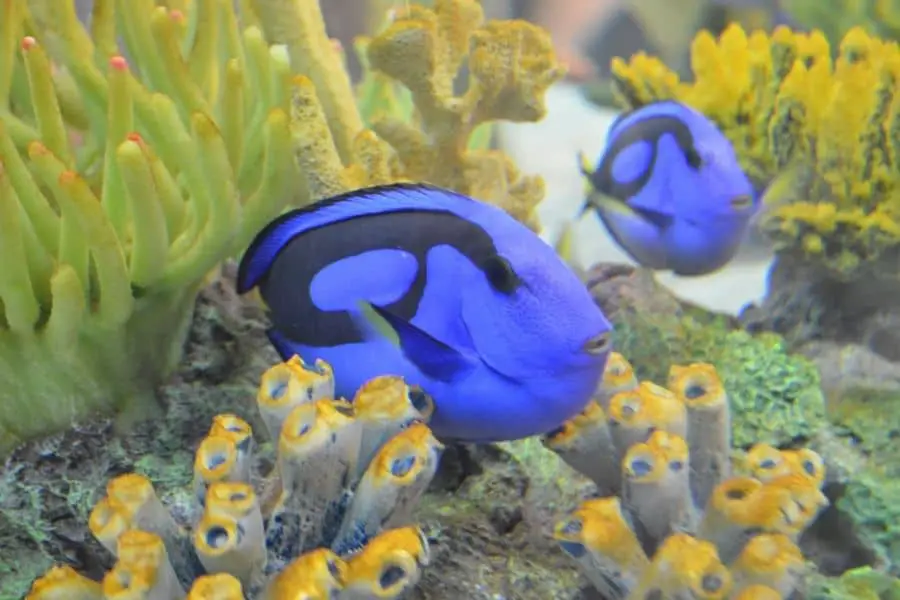
Is blue tang aggressive?
The blue tang is considered a semi-aggressive variety. Like other Tangs, they are territorial. Thus, there is a possibility to fight each other to protect their territory. But they are the best choice for community tanks. They can live along with the many fish varieties. But do not put them with members of the surgeonfish family.
Blue tang lifespan
They have a fairly good lifespan. Their lifespan ranges from 8 -12 years.
Blue tang care in Aquariums
| Category | Rating |
| Care Level: | Moderate |
| Temperament: | Semi- Aggressive |
| Color Form: | Blue color body with black markings |
| Lifespan: | 20-30 years |
| Size: | Grow up to 12 inches |
| Diet: | Omnivore |
| Family: | Acanthuridae |
| Minimum Tank Size: | 100 Gallons |
| Tank Set-Up: | Freshwater with plants and caves |
| Compatibility: | Species tank or peaceful community |
tank size
In the wild, blue tang grows around 12 inches in size. Adult fish weight is around 600 g. Thus, you should have at least 100 gallons tank to rear them healthily. If you have two Blue tangs, the 200 gallons tank is ideal for them. Blue tangs enjoy the swimming space. Hence, if you want to rear more than two blue tangs in your aquarium, you will need a pretty large tank. Therefore it is recommended to use a 6 feet length aquarium for healthy fish. If you add 1-inch wide juvenile fish into the tank, they can grow within several months.
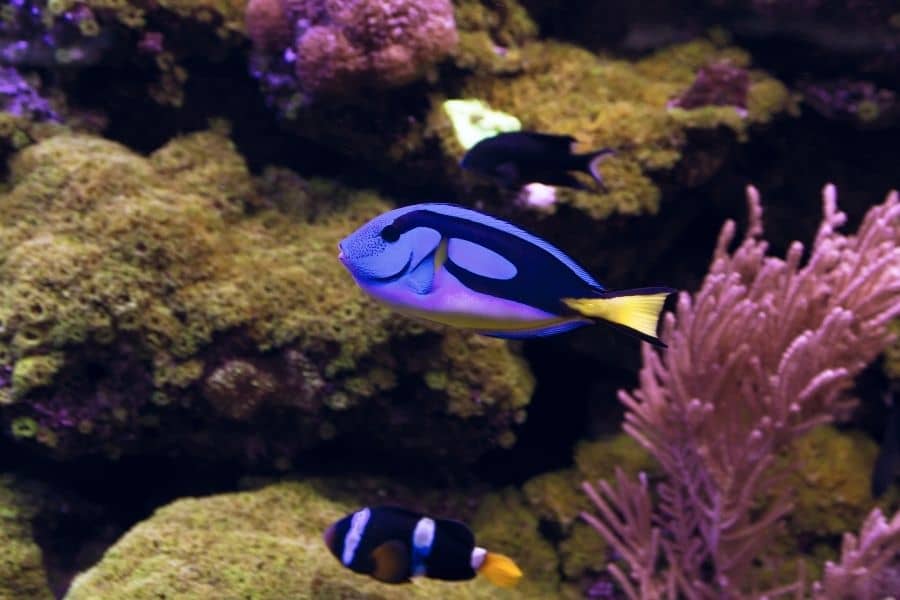
How many blue tangs should be kept together?
It depends on your tank size. If you want to rear two blue tangs together you should have a 200-gallon tank. If you want to rear more than two, you should take a larger tank for it. Normally one tang needs a 100-gallon tank. If you want to add multiple Blue tangs together, expand additional 100 gallons of space for one fish.
Tank setup
You should have a good saltwater tank to rear Blue tang healthy. Thus, firstly, you have to consider the pH, water hardness, salinity, and water quality requirements of this fish. Moreover, it is better if you can arrange your tank with living corals or live rocks. Because those will give a much more familiar environment to them.
To enhance this natural experience, you can create some hiding places in your aquarium by using live corals, and PVC pipes. After you buy a new fish, firstly you should quarantine them in a separate tank before introducing them into the main aquarium. Because newcomers can consist of some marine parasites such as Ich. Thus, you should ensure their health condition before adding them to the main aquarium.
Water quality conditions required
Keeping your tank water of good quality to rear healthy fish. Below I mentioned the ideal water quality parameter for Blue tang. Please follow the following guidelines to enhance the lifespan of your “Dory”.
Water Temperature
They prefer to live in 75 oF – 82 oF (25 oC – 28 oC) water temperatures. You can set up an aquarium thermometer to check water temperature regularly.
Water pH
Water pH should be maintained between 8.0 – 8.4. You can purchase a pH meter to check your water pH.
The salinity of the water
It is essential to provide saline water to saltwater fish. You can mix aquarium salt with fresh water to create the correct salinity level at home. Add 34 grams of salt to water one liter to create a 34 ppt solution. The salinity level should be at 34 ppt (part per thousand). If you are using tap water, treat them with a dechlorinating agent.
You can measure the salinity of the water using a portable salinity meter. If you are going to rear saltwater fish species, it is better to have a salinity meter. You can purchase it from the local market. Because water salinity is the most important factor to control fish osmosis. Poor salinity management can kill your fish.
Water Hardness
Generally, ideal water hardness is between 8-12 dKH
Ammonia, Nitrate and Nitrites level in the water
These are the substances that generate in your tank as a result of uneaten food and fecal matter. But it directly affects water quality and spoils the water. Thus, you should use a good filter system to maintain Ammonia, Nitrates, and Nitrates levels at zero.
Filter System
It is essential to have a good filter in a Blue tang tank. Water quality can be reduced because of fecal matter and uneaten food particles. Further, the filter system provides a good oxygen supply to the tank. You can use a sponge filter or mechanized filter to accomplish this purpose. Moreover, you can use biological filters too.
How does Blue tang breed in the wild?
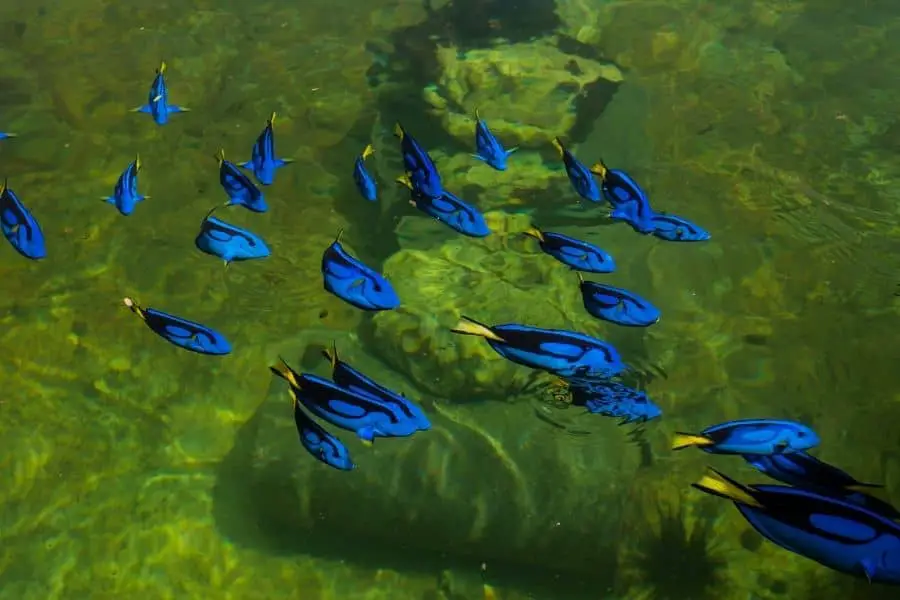
In the wild, Pacific Blue tangs get together as a breeding group. The female fish suddenly swim upward of the water column. Female Blue tang fish lay around 30,000- 40,000 eggs above the coral reefs. These eggs are 0.8mm in size and contain a single drop of fat oil to buoyant in the water column. The males swim above the eggs and fertilize those using their sperm. These eggs hatch after 24 hours and release the fried fish into the natural environment. If you want to breed Pacific Blue tang fish at your home, it is recommended to purchase a pair that is already bonded. It is easy for you.
How do identify female blue tang?
It is not easy to identify the male and female genders clearly. Because the physical appearance of male and female fish are the same. But at the same age blue tang females have slightly smaller bodies than male tangs.
Blue tang male vs. female differences
The Pacific Blue tang male and female fish are not showing obvious differences. The male black line stops near the eyes and the female black markings go further than it. Moreover, male fish have a slightly larger body than female fish. You can identify their sex when they are ready to spawn. Because females carry thousands of tiny eggs in their bellies. Thus, their belly is more rounded than males.
Do Blue tang males or females change their color?
Yes, they change their color when they are stressed. When they are stressed, their black markings are discolored and turn into a white color.
Blue tang changes their color at night time too. Their nervous system activities are changing at night time and because of that adult fish’s bright blue color turns into a violet-tinged white color or pale blue color at night.
How to breed
Until 2016, breeding in captivity was not successful. But these days they breed in aquaculture farms under controlled conditions. They need some special requirements to breed in captivity. Thus, breeding them in a home is a bit difficult. Thus, farmers use greenhouses to breed them at the industrial level. They use intensive farming to breed them.
Here are the steps followed by fish experts.
- Select disease-free brood stock that has good colors and body shapes
- Take a 500-gallon breeding tank or hatchery tank (1000 liters)
- Install Water filter with 10 liters per minute flow rate
- They require moderate aeration. Give it, using an aerator
- Use Single point source light in the breeding unit. The breeding unit needs light for 16 hours and dark for 8 hours
- Water temperature should be between 78 oF- 82 oF
- The salinity level of the water should be at 34ppt (add 34 grams of aquarium salt for one gallon of water)
- Add male and female fish into the breeding tank
- They will spawn at night time and release around 30,000 eggs
- Then eggs will hatch within 24 hours
- There are thousands of juvenile fish released into the water
- Remove parent fish from breeding setup
- They have an 80% survival rate
- Feed fry stage of blue tang using rotifers or Parvocalanus nauplii for 40 days
How many babies does blue tang have?
They lay around 30,000 eggs in one spawn and males fertilize those tiny eggs. Thus, Blue tang can produce thousands of babies per one spawn. Normally 80% of their eggs are successfully hatched. Thus, the surviving rate is 80%.
Blue tang fry/Juveniles appearance
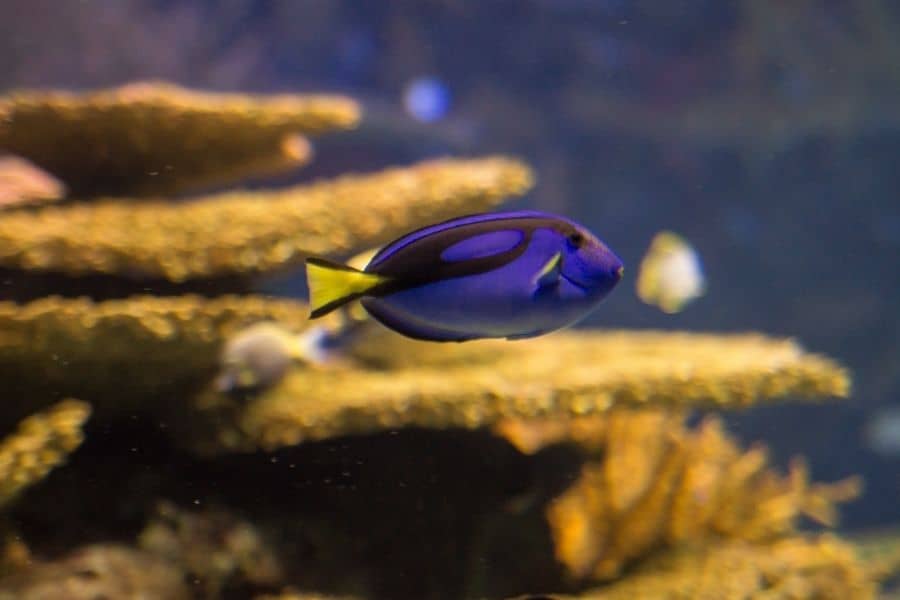
At the very beginning, the fry size is around 2 mm. Further, blue tang juveniles have transparent bodies. They have black spots on the top of their head and tail area. The electric silver color internal organs can be seen in the head area of the fish.
Gradually, they grow by eating plankton, rotifers, and other micro-size food particles. After 47 days of post-hatch, the blue color appears. This blue color spreads throughout the body. After 78 days, they grow up 1.5-2 inches in size. In this stage, their body is fully covered with blue color and has well-developed black markings.
How to care for Blue tang fry?
In the wild, the juvenile stage of blue tang relies on plankton. In captivity, people try various foods to feed them. Among those foods, the following foods are the best selections for fry fish. After the egg hatch, you can give food that shows in the following table. You can use one or more types of feed along with another feed. Then juveniles can eat feed that they mostly prefer.
| Fry age (days) | Feeds of Blue tang fry |
| First 2 days | They eat their egg sac, Thus, need not any feed |
| First 40 days of Blue tang juvenile | Parvocalanus nauplii |
| First 45 days of Blue tang juvenile | Rotifers |
| After 20 days of their birth | Artemia or Brine shrimp |
| After 30 days of their birth | Start micro diet |
When does Blue tang fry get mature?
They reach maturity within a 9-12 months period. After this period they can live around 20-30 years in the wild.
What are the benefits of farming Blue tangs?
They are bred in captivity. Therefore it has some advantages over blue tang that is collected from the wild. They can adjust captivity conditions more easily than wildly captured fish. Moreover, they do not carry marine diseases such as Ich.
What does blue tang eat in the wild?
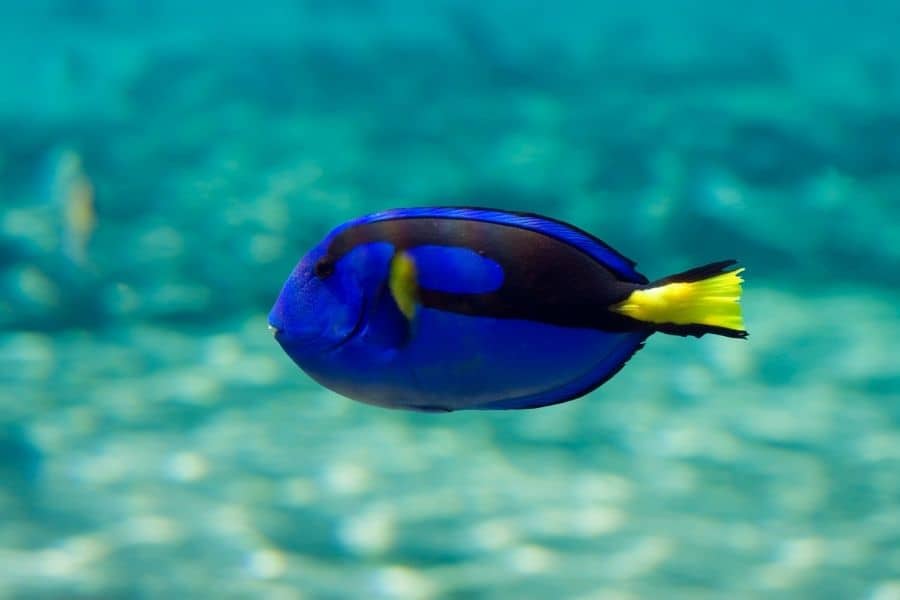
The blue tangs are omnivorous. Thus, in the wild, their diet is primarily based on algae that are attached to the coral reefs. Moreover, they eat microalgae that are abundant in seaweeds and grasses.
What to Feed blue tang in the Aquarium?
The fish is an omnivore. Because of that, they can feed animal matter, plant matter, and algae. In the wild, they much prefer to eat algae. Thus you can give the following food types to feed your fish in the aquarium.
- Algae flakes
- Nori sheets
- Spirulina flakes
- Mysis shrimp
- Brine shrimp
- Live Seaweeds
- Freeze Dried Seaweeds
- Veggie mixed flakes
How long can blue tang go without food?
Blue tang can live around 3-5 days without any formulated feeds. Because they highly depend on algae matters. There are lots of algae in most aquariums. Thus, they can rely on natural foods for a longer period. But if your aquarium has not had enough algae you can you an “Auto Feeder” machine to feed them easily.
When to feed blue tang?
In the wild, they are always searching for food and picking them. In captivity, you can add feed at least twice per day for well-grown blue tang fish. If you have a juvenile blue tang, feed them three times per day. Because juvenile stages need more energy to grow than adult stages. You can add feed around 9 am 1.00 pm and 5.00 pm.
How much to feed blue tang?
The required amount of feed depends on their life stage. A small fish needs more food than a younger one. Further, it depends on the available food matters and the amount in the aquarium. Because a normal aquarium contains lots of algae in glasses and substrates. Thus, blue tang fish can rely on those algae too.
What fish can live with blue tang in an aquarium?
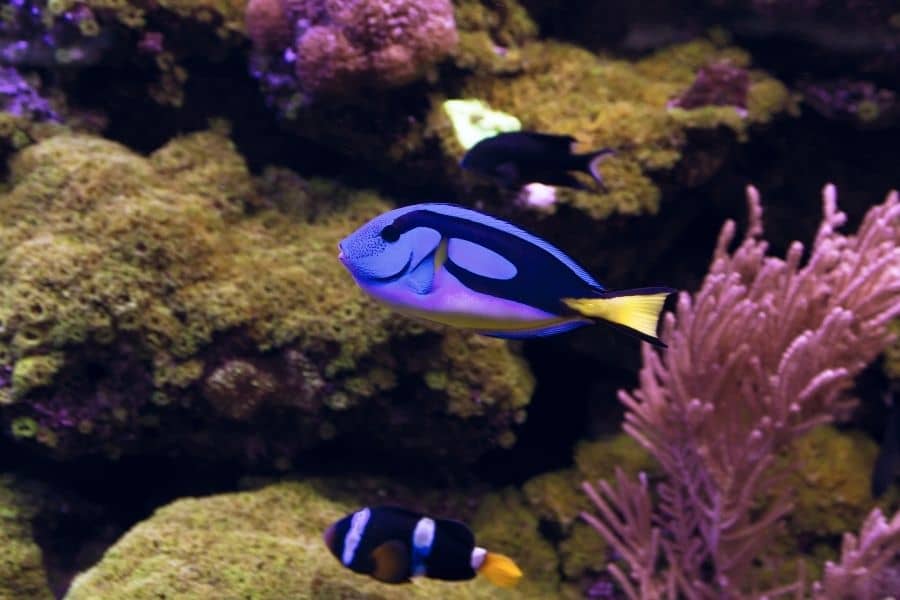
Generally tang fish can live in a community tank. You can add them with the following tank mates. Make sure that you should add saltwater species as tank mates. You cannot add freshwater species.
- Clownfish
- Cardinals
- Large Angels
- Damselfish
- Dottybacks
- Wrasse
- Gobie
Blue tang diseases
You can identify diseased fish by observing their behavior. Normally infected fish have several signs. These are abnormal swimming patterns, discoloration of the body and fins, loss of appetite, aggressiveness, and lethargic symptoms. The below table has common diseases of blue tang and treatments for it.
After you purchase fish from a market, you should quarantine them for 2 weeks in the quarantine tank. Because they will contain lots of bacteria, parasites, and foreign materials. Thus, do not add them directly to the main aquarium. If you see any disease symptoms, separate that fish into a quarantine tank for the treatments. If not, the disease will spread in the whole tank.
Diseases of Blue tang
| Disease name | Cursive Agent | Symptoms | Treatments |
| Head and Lateral Line Erosion Disease- HLED | Nutrient deficiency | Erosions of fish head and lateral line De-coloration of the body Blue color turns into pale and black color turns into brown color. | Provide quality feed at least 2 times per day. Maintain water quality at a good level and maintain the correct salinity level in the tank (34 ppt ) |
| Velvet disease Marine ich Saltwater ich White spot disease | Protozoan parasites Cryptocaryon irritans. | affects the fish immune systemWhites spotsLethargyLack of appetite hiking behaviorsInfect the girls by avoiding light-heavy breathing while swimming into a powerhead. | Copper is very effective Affected aquariums should be treated for a minimum of 3–6 weeks. Cryptocaryon parasites remain for up to 4 weeks, depending on temperature. Combination of Freshwater dip, followed by a formalin bath Give adequate seaweed diets. |
| Skin Hemorrhage | By water quality and stress | De coloration of the body | Maintain water quality parameters pH -8.2 Temperature – 75 oF Salinity – 1.025 Ammonia – 0 Nitrite – 0 Nitrate – 0 |
| Black spot “disease” tang disease or black ich | Paravortex turbellaria flatworms embedded in the skin of the fish | Black spot on body and fin membranes | Freshwater dip, followed by a formalin both praziquantel can use |
Related questions
Is blue tang poisonous?
Yes, like most coral fish, Blue tang fish flesh is poisonous. They contain a toxin called ciguatera. Ciguatera poisoning can occur when you eat the flesh of the blue tang fish. Diarrhea, headaches, muscle pain, and heart problems can occur if you eat their meat. Moreover, ciguatera poisoning can kill humans. Thus, do not eat their flesh.
Is blue tang dangerous?
Normally they live peacefully in natural habitats and also in captivity. But they contain 9 dorsal spines, 3 anal spines, 26 to 28 dorsal rays, and 24 to 26 soft anal rays. Moreover, they have a dominant caudal spine in the caudal fin. They use these surgeons’ scalpel-like spines to protect them from predators and humans.
Is blue tang played as a dead person?
Yes, they do. Blue tang uses small tricks to protect from predators. When a predator comes to hunt them they act like dead fish. They lie down on their side and stay steady without any motion until the threat has passed them.
Does blue tang eat plants?
Because they are omnivores and they can eat animal matter, plant matter, and also algae. But they highly prefer to eat planktons and algae. They have sharp tiny teeth in their pointed nose-shaped mouths to pick the algae easily.
Are blue tangs rare?
International Union for Conservation of Nature (IUCN), listed the Blue tang as a “Least Concern” species. Female blue tang lay thousands of eggs at one spawning and thousands of juveniles are released into the water after 24 hours.
Because of that they are not rare and can be found in coral habitats in the Indo-Pacific region. But currently, a high amount of Pacific Blue tangs collect for the Ornamental Industry. Around half a million blue tangs are collected from the wild per year for the Ornamental trade. Moreover, until 2016, there is no proper technique to breed them in captivity. Thus, in past years there is high pressure on the blue tang.
How to collect Blue tang from the wild?
It is not easy to collect fish varieties associated with the coral. Because they quickly hide in the cavities and caves of the corals. People use cyanide and destroy the coral habitat to collect Blue tang fish. But it is an unacceptable thing, as it will destroy the whole coral habitat and kill a large number of aquatic creatures and fish.
How much is a blue tang worth?
The price of Blue tang fish varies with the size and quality. You can purchase small Blue tangs for around $25 and well-grown adult Blue tangs for around $75 – $ 80.
Related articles: Crystal Red Shrimp (Cardinal cf. cantonensis) Care | Complete Guide|
